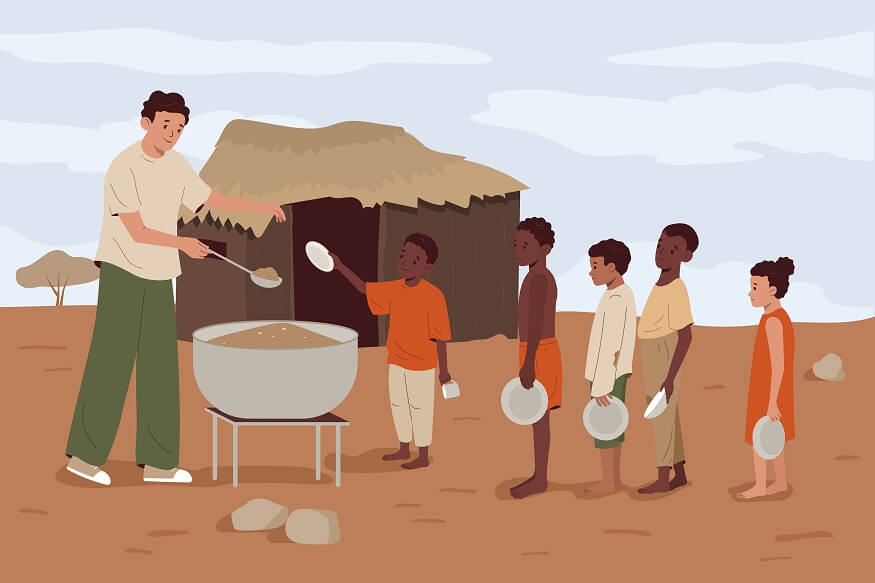Over 2.3 crore children in India suffer from malnutrition and are underweight. The World Health Organisation (WHO) reported that in 2020, roughly 149.2 million children under five were stunted (low height for age), 45.4 million were wasted (low weight for height), and 38.9 million were overweight. Sadly, these numbers have stayed high for a long time.
Childhood malnutrition can have severe health consequences. However, since malnutrition is a serious concern and we can prevent it, we need to work hard to address the problem. Evidence-based strategies should encompass adequate food supply, improved health services, healthy living environments, and proper care practices. Prioritising these areas can significantly reduce the prevalence of malnutrition and its associated health risks among children globally.
Research indicates that investing in addressing malnutrition is economically productive. Every $1 invested in nutrition-specific interventions yields up to $16 in return. Thus, prioritising nutrition in the global health agenda is not only a moral imperative but also a sound economic strategy.
In this blog we discuss the global perspective on malnutrition, identify its underlying causes, and the interventions to prevent it.
Also Read: What is the Difference Between Essential and Nonessential Nutrients
What is malnutrition
Malnutrition is a state of nutritional imbalance wherein an individual’s body receives a disproportionately low or excessive intake of nutrients. It can have dire consequences on one’s health, well-being, and survival, making it imperative to understand, prevent, and treat this condition
The two primary types of malnutrition are undernutrition and overnutrition. Undernutrition is more prevalent in developing countries, and it largely results from consuming inadequate amounts of nutrients essential for growth and maintenance.
The deficiencies may exist across various nutrients including proteins, carbohydrates, minerals, and vitamins, giving rise to conditions like stunting, wasting, underweight, and micronutrient-related malnutrition. On the other hand, overnutrition arises from excessive consumption of certain nutrients, particularly fats and sugars, leading to obesity and related health problems such as heart disease, diabetes, and certain cancers.
Malnutrition impacts the body severely. It compromises the immune system, making one susceptible to infections and diseases. Undernourished children particularly experience developmental delays, poor brain function, and reduced learning capacities. Overnutrition, on the flip side, increases the risk of chronic conditions, poor mobility and mental health problems.
Also Read: The Importance of Good Nutrition for Children
Causes of malnutrition
The impact of malnutrition is disproportionately severe among low-income families and communities both in developed and developing countries.
Malnutrition is caused by various factors. These triggers, often interrelated, span across the domains of social, economic, and health-related elements. Below are some of the causes of childhood malnutrition:
- Poverty: A critical cause of childhood malnutrition is poverty. Low economic stability often puts people in a situation where individuals lack consistent access to sufficient nutritious food for an active, healthy life. In such conditions, access to nutritionally wholesome food becomes exceedingly challenging, consequently increasing the likelihood of childhood malnutrition.
- Disease burdens: When children’s bodies are fighting off diseases, physical weakness and reduced appetite often result. Simultaneously, certain ailments can amplify the body’s nutrient demands or hinder nutrient uptake. Infections like HIV/AIDS, malaria, and diarrhoea can exacerbate malnutrition in children, setting them in a vicious circle of malnutrition and disease.
- Education and gender inequality: Mothers who lack basic education may not comprehend the rudiments of a balanced diet or the significance of exclusive breastfeeding for infants’ initial six months. Additionally, societal practices in certain cultures may favour boys over girls, causing gender-based nutritional disparity and increasing the rate of malnutrition among female children.
- Inadequate health services and harmful food environments: Lack of availability or access to quality health services could prevent timely recognition and treatment of childhood malnutrition. At the same time, unhealthy food environments that frequently advertise and sell processed foods high in sugar, oil, and salt can spur malnutrition in the form of obesity.
- Climate change: Extreme weather conditions can devastate crops, leading to decreased food production. This, in turn, can spike staple food prices, making nutritious food less affordable for the underprivileged, and thereby promoting malnutrition.
Also Read: Tips To Strengthen Your Body Immunity
Signs and symptoms of malnutrition
Symptoms of undernutrition include:
- Low body weight
- Stunted growth and poor intellectual development in children
- Constant fatigue and an overall lack of energy
- Dry, inelastic skin, rashes and lesions.
- Brittle hair, hair loss and hair pigment loss
- Compromised immune system
- Frequent infections and illnesses
- Shortness of breath, dizziness, or a rapid heartbeat
- Mood changes and irritability
Symptoms of overnutrition include:
- Obesity
- High blood pressure
- Insulin resistance
- Heart disease
Also Read: Tips To Planning the Perfect Lunch Box for Your Child
Interventions to prevent malnutrition
Preventing malnutrition needs a multi-pronged approach. Below are some of the interventions that can be taken:
- Give priority to the 1000 days: A baby’s first 1,000 days are super important for their health and intellectual growth. It is also a period when the child can potentially suffer from problems like infections or diarrhoea or is underweight. Breastfeeding is crucial at this time because it helps protect them from getting sick, and it is the best food and protection for a baby, especially for the first six months.
- Focus on prevention: Treatments for malnutrition do not take away the need for preventive strategies. Malnutrition cannot be eliminated without adequate information, awareness and preventive measures.
- Plan long-term nutrition-specific interventions: Nutrition needs to be made an important factor when devising policies for food security, agriculture as well as water and sanitation. The important question is what happens to severely malnourished children when after treatment they go back to the same environment of chronic food insecurity? Building feeding programmes, providing access to healthy foods, breastfeeding etc. are some of the interventions which need to be devised.
- Build a community of health workers: Building a network of community health workers focused on malnutrition can help disseminate information about malnutrition at the grassroots level. They can be made partners in the successful implementation of interventions around malnutrition.
Fresh governmental policies, backed-up nonprofit interventions, appropriate funding, and collective community effort are needed to ameliorate malnutrition. This would involve measures such as adequate dietary intake for pregnant women, optimum breastfeeding practices in the first 6 months, and introduction of appropriate complementary foods thereafter. Timely measures could break the cycle of intergenerational malnutrition, transforming lives and ultimately contributing to the socioeconomic development of communities, countries and the world at large.










